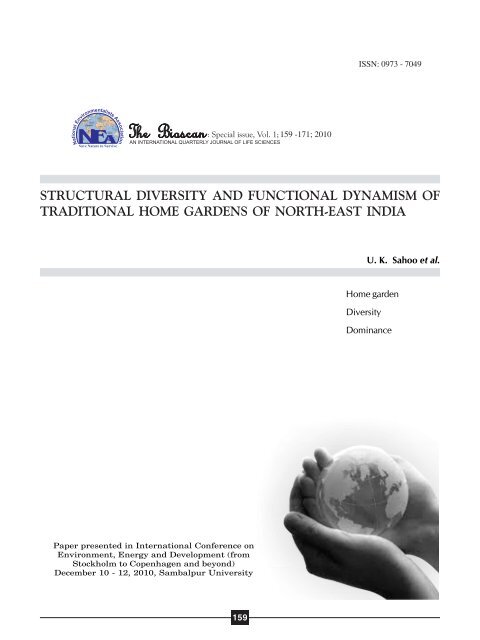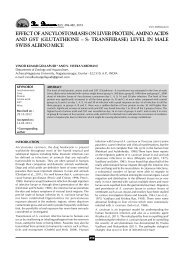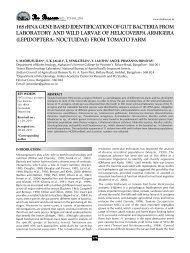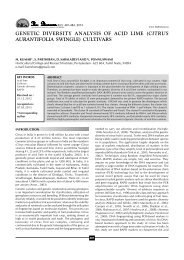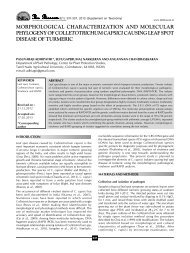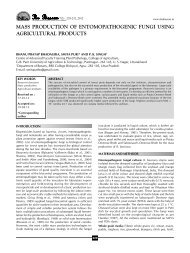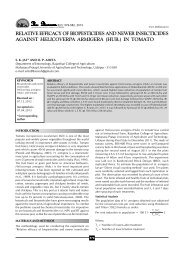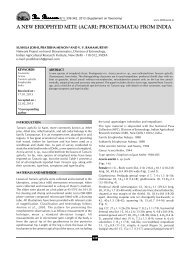full paper - THE BIOSCAN
full paper - THE BIOSCAN
full paper - THE BIOSCAN
You also want an ePaper? Increase the reach of your titles
YUMPU automatically turns print PDFs into web optimized ePapers that Google loves.
ISSN: 0973 - 7049<br />
: Special issue, Vol. 1; 159 -171; 2010<br />
NSave Nature to Survive<br />
STRUCTURAL DIVERSITY AND FUNCTIONAL DYNAMISM OF<br />
TRADITIONAL HOME GARDENS OF NORTH-EAST INDIA<br />
U. K. Sahoo et al.<br />
Home garden<br />
Diversity<br />
Dominance<br />
Paper presented in International Conference on<br />
Environment, Energy and Development (from<br />
Stockholm to Copenhagen and beyond)<br />
December 10 - 12, 2010, Sambalpur University<br />
159
NSave Nature to Survive<br />
U. K. SAHOO*, P. ROCKY, K. VANLALHRIATPUIA AND K. UPADHYAYA<br />
Department of Forestry, Mizoram University, Post Box-190, Aizawl - 796 009, INDIA<br />
E mail: uksahoo_2003@rediffmail.com<br />
ABSTRACT<br />
Forty five homegardens (size from 0.035ha to 2 ha) positioned in North-East India was studied<br />
in details for their structural and functional dynamism in relation to livelihood support. A total of<br />
107 different plant species (27 herbs, 15 shrubs, 7 climbers and 58 trees) belonging to 48<br />
families and 87 genus were recorded. Shannon Weiner index for both trees and shrubs were<br />
maximum in the small homegarden (H´=3.28, p
INTRODUCTION<br />
Home gardens are traditional farming systems which may have evolved over time from the practices of<br />
hunters/gathers and continued in the ancient civilizations up to modern times, therefore is one of the oldest<br />
agro-ecosystems that exist throughout the world (Soemarwoto, 1987; Soemarwoto and Conway, 1992). Many<br />
studies on home garden in other parts of world have revealed that home gardens are dynamic systems and<br />
are highly acknowledged for retaining higher diversity that represents microenvironments within larger<br />
farming systems; a mimics the natural, multi-layered ecosystem; and is agro-ecosystem (Agelet et al.,<br />
2000; Nair, 2001; Vogl-Lukasser et al., 2001; De Clerck and Negreros-Castillo, 2002; Gessler et al., 1998;<br />
Hoggerbrugge and Fresco, 1993). These homegardens are considered to be ecologically sustainable<br />
(Torquebiau, 1992; Jose and Shanmugaratnam, 1993; Kehlenbeck and Maass, 2004) probably because of<br />
their near-nature characteristics – higher species diversity, multi-strata canopy and a closed nutrient cycling.<br />
Variation in size, species composition and management objectives have been frequently reported (Fernandes<br />
and Nair, 1986; Christanty, 1990; Das and Das, 2010).<br />
In Mizoram in North-East India, homegarden is the major land use system next to shifting agriculture.<br />
Apart from supplementing food production through shifting cultivation, homegardens supply additional daily<br />
needs of the farmers such as fibres, spices and condiments, timber for agricultural tools, medicines, fodder,<br />
fuelwood etc. Also traditional homegardens are equally important for their potential role in soil protection<br />
and water conservation in the highly fragile hill ecosystems of the region. These homegardens in the state<br />
vary in their sizes influencing the species density and composition (Sahoo, 2009). It is expected that with<br />
different sizes, density and compositional pattern the edaphic characteristics in the homegardens also vary<br />
and may demand different management interventions for improving the overall sustainability of these important<br />
land use systems. However these traditional gardens in the state have received little scientific attention. In<br />
this <strong>paper</strong> we report the structural diversity and functional dynamism of 45 homegardens along a size<br />
gradient located in Mamit district of Mizoram in North-East India.<br />
MATERIALS AND METHODS<br />
Study sites<br />
For carrying out the detailed inventory on homegardens, individual households having (>0.01 ha) were<br />
taken as the sampling units. At the household level, data were collected using various phytosociological<br />
tools for species composition, observations were made on plant use and interviews were conducted on<br />
productivity component and monetary return. Prior to the interviews, the homegardens were personally<br />
visited to observe the overall conditions of the systems. A minimum of 15 households were interviewed in<br />
each village and in total 45 (15x3) homegardens were selected. For crop composition, the garden area was<br />
measured, and the different species of crops and trees present were identified and enumerated. The population<br />
of annual crops and other widely grown small plants was estimated by making sample counts on systematically<br />
selected 1m x 1m quadrats and extrapolating it to the area it covered. Individual trees and shrubs present in<br />
the garden were counted. Information on the use, practice and management of plant/crop species was noted<br />
in the field itself by following a standard questionnaire. Most of the plants encountered in the present study<br />
had multiple uses but classification was done based on the main use that was illustrated by farmers.<br />
Vegetation analysis<br />
In each homegarden, vegetation data like density, frequency and abundance of different plant species were<br />
measured directly (Phillips, 1959). The sum of relative frequency, relative density and abundance was<br />
calculated as importance value index (IVI) of individual species (Curtis, 1959). All species present were<br />
classified into: annual/biennial/perennial or herb, shrub and tree. To determine crop species diversity,<br />
species richness and species evenness of the homegardens were calculated. Species richness is the total<br />
number of crops on a homegarden. Species diversity (Margalef, 1968) was calculated as: H ’ = -” {(n i<br />
/N)<br />
log e<br />
(n i<br />
/N)}, where H’=Shannon index of general diversity, n i<br />
=IVI of a species, N= Total IVI of the<br />
161<br />
FUNCTIONAL DYNAMISM OF TRADITIONAL HOME GARDENS
U. K. SAHOO et al.,<br />
community (i.e. 300). The dominance index (Simpson, 1949) of the community was calculated as: C=” {(n i<br />
/<br />
N) 2 }, where C=dominance index, n i<br />
and N are same as for Shannon’s index. Pielou’s (1966) evenness index<br />
(e) was calculated as: e= H’/logS, where H’= Shannon’s index of diversity, and S= Total number of<br />
species. Sorenson’s similarity index (Sorenson, 1948) was calculated as, [2C/(A+B)] x 100], where, A and<br />
B are the total species content (trees, shrubs or herbs) in stand A and B respectively, while C is the number<br />
of species common to both stands.<br />
Soil analysis<br />
Five cores (6.5 cm inner dia) from 0-15 cm and 15-30 cm depth were collected from each selected homegarden<br />
in the month of March. All the soils collected were pooled garden-wise and depth-wise and sieved through<br />
2mm mesh screen. The soil moisture content (SMC), pH, ammonium-N and nitrate-N were determined<br />
within 36 hours of sampling following standard procedures given in Anderson and Ingram (1993). Rest of the<br />
soil samples were air-dried and analyzed for total kjeldahl nitrogen (TKN) using Kel Plus (Pelican model),<br />
while available phosphorous and soil organic carbon (SOC) was estimated by molybdenum blue method and<br />
rapid titration method respectively as given in Allen et al. (1974). Water holding capacity (WHC) was<br />
determined using Keen’s box and the SOC values were multiplied by a constant (1.724) to obtain the soil<br />
organic matter (SOM) values (Allen et al., 1974). Soil texture was determined by Boucous hydrometer<br />
method (Anderson and Ingram, 1993).<br />
Microclimatic variables<br />
The microclimate in the home gardens were studied by measuring light intensity, relative humidity and air<br />
and soil temperatures. The light intensity was measured using a digital lux meter. The air temperature and<br />
relative humidity were measured using a thermo-hygrometer. Soil temperature was measured using a soil<br />
thermometer.<br />
Energy input/output<br />
A process analysis was used to measure energy flow (Fluck, 1992) adding human work contributions (Odum,<br />
1996). Internal and external inputs were measured in Mega Joules (MJ). These were estimated by extrapolating<br />
standard energy values (Mitchell, 1979; Mittal and Dhavan, 1989 and Gopalan et al., 1982). The input of<br />
energy through seeds was calculated on the basis of total energy expended to produce that fraction of the<br />
crop yield. The economic yield per hectare in all cases was calculated on the basis of the entire plot. For<br />
calculating the output of energy the total economic yield of various crops was converted into mega joules of<br />
energy by multiplying with similar standard values. The energy efficiency of each system was calculated as<br />
the output/input ratio.<br />
Input of household labour is a component that needs to be factored to an economic valuation. For the purpose<br />
of this study, opportunity cost of household labour is calculated as a function of time, OC HL<br />
=ƒ (t * labour<br />
rate), where t is the time spent in the garden. The opportunity costs of land have been assigned values<br />
equivalent to the rate at which farmers were able to lease out all or parts of their lands. This rent was<br />
calculated to be an average of Rs. 9500 per hectare of the land per year. For monetary input/output analysis,<br />
labour charge was calculated on the basis of prevailing daily rates of Rs 70. The monetary returns in terms<br />
of crops, feed, milk, egg and organic manure were calculated based on prevailing market price for each<br />
commodity.<br />
RESULTS AND DISCUSSION<br />
Garden size, vegetation composition and dynamics<br />
The size ranged from 144 m 2 to 0.9 ha with a mean of 0.3 ha area. The average homegarden size in small<br />
category was 1152 m 2 , 3895 m 2 in medium and 8500 m 2 in large gardens in the three different villages. The<br />
altitudinal range varies from 56 m asl to 960 m asl. The location of the homegarden in the three villages<br />
ranged from 23º48´58.2½ N to 23º54´53.5½ N latitude and 92º29´41.9½ E 92º25´27.4½ E longitude.<br />
162
Table 1: Species richness of the different homegardens of<br />
Mamit district of Mizoram, North-East India<br />
Homegarden types Family Genus Species<br />
Small 42 68 81<br />
Medium 34 47 53<br />
Large 27 34 37<br />
Overall 48 87 107<br />
Table 2: Composition of different plant forms (habits) in the<br />
homegardens of Mamit district of Mizoram, North-East India<br />
HomegardenTypes Trees Shrubs Climbers Herbs<br />
Small 42 10 6 23<br />
Medium 35 7 2 9<br />
Large 21 6 1 9<br />
Overall 58 15 7 27<br />
Table 3: Similarity Index (Jaccard’s Index) across the<br />
different homegarden types of Mamit district of Mizoram,<br />
North-East India<br />
Homegarden Types Medium Large<br />
Small Trees 0.400 0.313<br />
Shrubs 0.308 0.143<br />
Herbs 0.185 0.280<br />
Climbers 0.143 0.167<br />
Overall 0.314 0.269<br />
Medium Trees - 0.333<br />
Shrubs - 0.444<br />
Herbs - 0.385<br />
Climbers - 0.500<br />
Overall - 0.375<br />
Table 4: Diversity, Dominance and Evenness Index of trees<br />
and shrubs across the different homegardens of Mamit district<br />
of Mizoram, North-East India<br />
Homegarden Shannon-Weaver Simpson’s Evenness<br />
Types Diversity IndexH´ Dominance IndexJ<br />
Index Ë<br />
Small 3.28 0.051 0.75<br />
Medium 2.59 0.076 0.65<br />
Large 2.98 0.062 0.83<br />
163<br />
FUNCTIONAL DYNAMISM OF TRADITIONAL HOME GARDENS<br />
A total of 107 species were recorded from the<br />
different homegardens of Mamit district out of which<br />
54% were trees, 14% were shrubs, 25 % were herbs<br />
and 7% were climbers representing 48 families and<br />
comprising of 87 genera. Species composition was<br />
more in the small garden than the medium and large<br />
gardens and least was observed in the large gardens<br />
(Table 1). In all the homegarden types trees dominated<br />
followed by herbs and shrubs (Table 2). Similarity<br />
index shows that the vegetation compositions were<br />
not so similar among the different sizes of<br />
homegardens but similarity was highest between the<br />
large and medium sized homegardens (Table 3).<br />
Homegardens in all the three villages sampled<br />
irrespective of their sizes provide excellent<br />
demonstrations of the importance of ecosystem<br />
diversity for the evolution and conservation of plant<br />
genetic resources. In the sampled area a wide<br />
variation in homegarden size (0.01- e”1.00 ha) was<br />
encountered. Studies on homegarden systems from<br />
different ecological and geographical regions showed<br />
that the worldwide average size of homegarden units<br />
is around 0.10–0.50 ha. Among the plant families,<br />
Asteraceae, Caesalpinaceae, Compositae,<br />
Cucurbitaceae, Euphorbiaceae, Leguminosae,<br />
Mimosaceae, Moraceae, Musaceae, Papilionaceae,<br />
Rutaceae, Solanaceae, Verbenaceae and<br />
Zingiberaceae were the most dominant families in<br />
the home gardens, Solanaceae had the highest species<br />
number as it provides a variety of food crops like<br />
Abelmoschus esculentus, Solanum esculentum,<br />
Solanum khasiana, Solanum melongena, Solanum<br />
nigrum etc; followed by Euphorbiaceae, Moraceae,<br />
Rutaceae, Papilionaceae, Zingiberaceae, Musaceae,<br />
Mimosaceae and Verbenaceae. In other words, the food crops dominated in most homegardens.<br />
The Shannon Weaver index shows a higher diversity of trees and shrubs in the small homegarden (H´= 3.28)<br />
as compared to the medium and large homegardens. The diveristy index was least in the medium size homegardens<br />
which means that only few species were mode abundant. Species like Areca catehu, Citrus macroptera var<br />
anamensis and Camellia sinensis were more abundant than others in the medium sized homegardens but many<br />
other fruit and tree species were equally abundant in the small sized homegardens like Tectona grandis, Coffea<br />
Arabica, Clerodendrum colebrookianum, Mangifera indica, Areca catechu, Psidium guajava etc. The dominance<br />
index also shows that only a few species dominated the homegardens in medium sized homegardens (ë =<br />
0.076) as compared to large and small homegardens. Areca catechu and Camellia sinensis dominated the<br />
medium sized homegardens. The evenness index shows that in large sized homegardens most of the species are<br />
equally abundant (E = 0.83) than medium sized and small sized (Table 4).<br />
Our survey revealed 20 (10%) trees; 6 (7%) shrubs and 11 (8%) herbs common to all the home gardens<br />
studied. The species diversity of trees was more in small home gardens, followed by medium sized homegarden.<br />
A similar trend was also observed for shrubs, climbers and herbs. Species diversity index reported elsewhere<br />
in general from the homegardens is high. However, the diversity index found in the present study has been
U. K. SAHOO et al.,<br />
higher than reported for Thailand (Diversity index-1.9-2.7, Gajaseni and Gajaseni, 1999), more or less<br />
similar for Karnataka, India (Diversity index- 3.21, Shastri et al., 2002). All the home gardens surveyed in<br />
the present study had high species richness index which reveal high species number in an area, besides the<br />
distribution of individuals in the systems was significant with low dominance. These features depict that the<br />
home gardens of Mizoram are more stable and matured and therefore could be self-sustaining to generate<br />
high production output under low input conditions. The high diversity observed in the homegardens must<br />
have been due to selection of the species having the potentiality to meet varied requirements of the farmers/<br />
owners with utility of the specific products as the main criterion. There are other factors which too account<br />
for this high diversity, the notable among are the climatic and geographic locational advantages, other site<br />
characteristics, plot dimension, orientation and the extent of human interaction in the past and present.<br />
Further, the edaphic characteristics like soil fertility level, particularly the soil organic matter can influence<br />
directly the trees species diversity and richness.<br />
All the species irrespective of their habit were distributed contagiously (100%) in all the home gardens. A<br />
contagious or clumped distribution of trees, shrubs and herbs is an indication of clusteredness of species<br />
throughout the indigenous home gardens and the contagious distribution has been accepted as more of a<br />
characteristic pattern of plant occurrence in nature (Odum, 1971). It appears that the farmers have understood<br />
this natural concept through time and therefore have adopted strategies for introducing more and more tree<br />
species into their home gardens.<br />
Our findings reveal that species grown in the traditional home garden systems are confounded by the<br />
livelihood requirements and traditional wisdom although differences in species selection could well be<br />
related to altitudinal/climate regime. For examples, the species which provide substantial household<br />
requirements like Curcuma longa, Brassica juncea, Hibiscus sabdariffa, Eryngium foetida, Colocasia<br />
esculenta, Trevesia palmata, Artocarpus heterophyllus and Cucurbita maxima were found in more than 70%<br />
of the homegardens. The dominant tree species in the home gardens include Areca cathechu, Artocarpus<br />
heterophyllus, Citrus anamensis, Schima wallichi, Melia azedaratchta, Samania saman, Saprosma ternatum,<br />
Mangifera indica, Mimusops elengi, Psidium guajava, Parkia timoriana, Persea americana and Tamarindus<br />
indica and shrubs like Capsicum annum, Cajanus cajan, Clerodendrum colebrokianum, Musa paradisiaca,<br />
Musa acuminata, Citrus limon, Thysanolaena maxima, Hibiscus macrophyllus and Zea mays and herbs,<br />
Annanas comosus, Allium hookerii, Calamus tenuis, Colocasia affinis, Centella asiatica, Cucurbita maxima,<br />
Curcuma longa, Curcumphera longiflora, Ipomea batata, Spilenthes acmella and Sechium eduli (Appendix-I)<br />
It was observed that the most of the species grown in the homegardens were perennial followed by annuals.<br />
Only a few biennials were found in the homegardens. Further, it was noticed that the farmers have grown<br />
crops having different life cycles in their gardens, so as to draw food and other products throughout the year.<br />
Most of the plants/crops grown in the gardens have multiple uses and therefore they not only fulfill the<br />
nutritional requirement but also in certain cases the monitory needs by the sold of the products in the nearby<br />
local market. From our survey, seven major plant use categories were identified. The dominant species in<br />
relation to use category per homegarden, was the vegetable followed by medicinal and spice in herbs<br />
groups, in shrubs groups it was vegetable and followed by medicinal and miscellaneous species. However,<br />
in the tree group’s dominant category were fruits species followed by multipurpose and timber tree species.<br />
The overall picture revealed vegetables (32%) are the major constituents followed by fruits (15%), medicinal<br />
plants (13%), multipurpose tree species (13%), species of miscellaneous use (11%), timber (10%) and spice<br />
(6%) (Fig. 1).<br />
The structural composition of the homegardens resembles more of a natural forest ecosystem or like indigenous<br />
integrated method of home production systems with primary function of subsistence food production and<br />
contributions in the family cash economy upto certain extent. The main crops raised in the garden for<br />
marketing are Sechium edule, Parkia timoriana, Passiflora edulis, Persea americana, Carica papaya, Citrus<br />
anamensis, C. limon, C. reticulata, Allium hookerii, Areca cathechu, Ananas comosus and Zingiber officinalis.<br />
Majority of the farmers have revealed us to have sold more than 60% of their produce in the local market<br />
164
Number of species<br />
20.0<br />
18.0<br />
16.0<br />
14.0<br />
12.0<br />
10.0<br />
8.0<br />
6.0<br />
4.0<br />
2.0<br />
0.0<br />
Timber Fruits Vegetables Spice &<br />
condiments<br />
Use Categories<br />
SMALL<br />
MEDIUM<br />
LARGE<br />
Stimulant Ornamental Misc.<br />
FUNCTIONAL DYNAMISM OF TRADITIONAL HOME GARDENS<br />
purely for cash income. In general, the farmers having<br />
small gardens prefer to use all the products for family<br />
consumption.<br />
Soil nutrients dynamics in the selected home<br />
gardens<br />
The physical properties of soil like water holding<br />
capacity and moisture content differed significantly<br />
(p>0.05) between the gardens (Table 5). High soil<br />
moisture content recorded in the top (0-15 cm) layer<br />
in the present study might be ascribed to the greater<br />
accumulation of litter and other domestic waste on<br />
Figure 1: Use categories of plants across different<br />
gardens in Mamit district of Mizoram, North-East<br />
the floor of the traditional home gardens. WHC in the sites declined with decreasing depth registering<br />
greater value in the surface (0-15 cm) soil layer in all the homegardens. SMC always registered greater<br />
values in the upper soil layer compared to sub-surface layer. Soil texture between the sites was relatively<br />
consistent throughout the profile, which was typified by sandy loam to loamy sand. However, there was<br />
little variation in the particle fractionation across the profile increasing from surface soil layer to subsurface<br />
soil layer. These differences among the homegardens are likely due to combination of factors like<br />
microclimate, topography and plant species composition.<br />
Soil pH was acidic (5.37-6.04) in all the homegardens. This means that soils of the homegardens had<br />
favourable fertility conditions as far as pH is concerned. Production output from the homegardens was in the<br />
forms of fruits, leaves, young shoots, bark, flowers or other non-timber products. There was no complete<br />
harvesting from the homegardens. This mechanism ensured minimal nutrient export from the system. A<br />
comparison of soil fertility indicators, such as the pH, total nitrogen, organic matter and available phosphorus<br />
in the surface soil inside and outside the homegardens clearly showed higher soil fertility inside the<br />
homegardens. However, it is generally regarded that the homegardens possess a closed nutrient cycling,<br />
much similar to the tropical forests (Soemarwoto and Conway, 1991; Nair et al., 1999). Agroforestry<br />
systems compose of several different tree and crop species, spatial patterns of nutrient cycling also arise<br />
from differences between species with respect to growth, fertilizer rates, litter quantity and quality, root<br />
distribution and water requirements. Land use systems based on tree crops, such as multistrata agroforestry<br />
systems, have clear advantages over annual cropping systems for the maintenance of soil fertility in the<br />
Table 5: Soil physico-chemical properties of the home gardens of Mamit district of Mizoram, North-<br />
East India<br />
Parameters Large Medium Small<br />
soil depth (cm) 0-15 15-30 0-15 15-30 0-15 15-30<br />
Moisture<br />
Content (%) 33.41±0.51 29.54±0.41 30.32±0.89 27.8±0.55 26.82±0.38 23.37±0.71<br />
WHC (%) 61.22±1.76 48.57±1.59 55.32±2.55 43.56±1.21 51.06±0.95 45.21±1.27<br />
Soil texture<br />
Sand (%) 53.55±0.76 65.24±1.22 52.35±2.33 49.58±1.18 62.29±3.56 59.51±2.41<br />
Silt (%) 32.59±0.23 28.15±2.44 35.58±3.16 37.58±2.34 29.57±2.52 32.77±1.65<br />
Clay (%) 13.86±1.06 6.61±1.91 12.07±1.38 12.84±1.11 8.14±0.67 7.72±0.41<br />
Textural class Sandy loam Loamy sand Sandy loam Loamy sand Sandy loam Loamy sand<br />
pH 5.45±0.16 5.81±0.02 5.68±0.09 5.37±0.12 5.68±0.05 6.04±0.04<br />
Soc (%) 2.37±0.09 2.13±0.09 2.23±0.07 1.79±0.06 1.26±0.15 1.05±0.03<br />
SOM (%) 4.09±0.16 3.67±0.16 3.84±0.12 3.09±0.11 2.17±0.25 1.81±0.05<br />
TKN (%) 0.41±0.04 0.28±0.04 0.37±0.06 0.24±0.03 0.22±0.02 0.20±0.03<br />
C/N ratio 5.78±0.48 7.61±0.57 6.03±0.55 7.46±0.67 5.79±0.27 5.25±0.43<br />
NO -3 -N (μg g -1 ) 9.98±0.32 10.25±0.54 8.73±0.35 7.76±0.61 6.24±0.45 5.76±0.22<br />
NH -4 -N (μg g -1 ) 8.14±0.24 6.26±0.27 7.41±0.25 6.33±0.22 5.14±0.14 4.78±0.15<br />
PO -4 -P (μg g -1 ) 10.81±0.52 8.39±0.31 8.57±0.42 7.51±0.31 6.19±0.61 5.17±0.32<br />
WHC-Water holding capacity, SOC-Soil organic carbon; SOM- Soil organic matter; TKN- Total Kjeldahl nitrogen<br />
165
U. K. SAHOO et al.,<br />
humid tropics. These include permanent soil protection, a more favorable environment for soil biological<br />
processes which affect litter decomposition and soil structural improvement, and more efficient nutrient<br />
cycling (Schroth et al., 2001). The available forms of nutrients (NH + -N, 4 NO- -N and 3 PO- -P) varied<br />
4<br />
significantly (p>0.001) within the homegardens with greater values in the upper soil depth as compared to<br />
the subsurface soil layer. Greater values of NH + -N, 4 NO- -N and 3 PO- -P were recorded the in the larger<br />
4<br />
than the small home gardens. The soil physical properties like WHC, soil moisture content, were significantly<br />
positively correlated with soil chemical properties, which indicate that the nutrient concentration in soil<br />
depends on the soil structure (Table 6).<br />
Evidences from other studies also suggest that tree as a functional group may have beneficial effects on soil<br />
fertility as a result of aboveground litter inputs, and perennial root systems that improves soil structure,<br />
reduce leaching losses, pump water and nutrients from deeper soil depths, support soil food web continually<br />
and contribute belowground detrital inputs (Fisher, 1995; Schroth and Lehmann, 1995). The positive effects<br />
of agroecosystems crop species composition and<br />
richness on soil organic carbon and nitrogen<br />
management has been validated by Russell (2002) and<br />
also considered as an important implication for<br />
designing of agroecosystem for soil fertility<br />
management and carbon sequestration.<br />
Table 6: Correlation matrix (‘r’ values) of soil nutrients in<br />
large, medium and small categories of home gardens<br />
Soil nutrients Large Medium Small<br />
Soil organic matter large 1 0.700* 0.349<br />
Medium 1 0.824*<br />
Small 1<br />
Total N large 1 0.950** 0.744*<br />
Medium 1 0.880**<br />
Small 1<br />
NO-3-N large 1 0.876** 0.754*<br />
Medium 1 0.922**<br />
Small 1<br />
NH + -N large 1 0.874** 0.904**<br />
4<br />
Medium 1 0.945**<br />
Small 1<br />
PO - -P large 1 0.885** 0.657*<br />
4<br />
Medium 1 0.842*<br />
Small 1<br />
* Significant at 0.05 and ** Significant at 0.01<br />
Table 7: Energy output and input (MJ/100m 2 year -1 ) under<br />
different homegardens in Mamit district of Mizoram, North-<br />
East India<br />
Production Small Medium Large F-test<br />
measure<br />
Input (total) 125 (81) 38 (61) 31 (61)<br />
Output<br />
Fruits 605 (50) 685 (68) 798 (89)<br />
Vegetables (leaves, 3049 (110) 497 (115) 626 (97)<br />
pods, seeds, etc.)<br />
Tubers and 74 (81) 83 (46) 27 (40)<br />
rhizomes Total 3728 (93) 1365 (50) 1452 (75)<br />
Output/input ratio 27 ± 5.3 36 ± 7.4 54 ± 7.8 p
FUNCTIONAL DYNAMISM OF TRADITIONAL HOME GARDENS<br />
Homegarden economics<br />
Virtually all species in the homegarden have a multiple use. Higher number of species in the large homegardens<br />
obviously contributed to higher production resulting into availability of more products for sale after household<br />
consumption. Sale of surplus was much higher among the larger gardens which were with commercial<br />
motives and also among some of the medium size gardens with similar strategies while higher proportion of<br />
the products was consumed in the households in most of the smaller gardens. Major portion of the fruit<br />
species like P. guajava, C. reticulata, Passiflora edulis, rhizomes like Zingiber officinalis and pods of P.<br />
timoriana were sold out in the local market as the production are usually high and not all the products could<br />
be consumed within the household. The monetary input significantly vary from Rs. 928 per 100 m 2 in small<br />
to Rs. 228 per 100 m 2 in large gardens (p
U. K. SAHOO et al.,<br />
Clerck De, A. J. F. and Negreros, C. P. 2000. Plant species of traditional Mayan homegardens of Mexico as<br />
analogs for multistrata in agroforest. Agrofor. Sys. 48: 303-317.<br />
Curtis, J. T. 1959. The vegetation of Wisconsin: An ordination of plant communities. The university of Wisconsin<br />
Press, Madison. WI.<br />
Das. T. and Das, A. K. 2005. Inventorying plant biodiversity in homegardens : A case study in Barak Valley,<br />
Assam, North East India. Curr Sci. 89(1): 155-163.<br />
Das, T. and Das, A. K. 2010. Litter production and decomposition in the forested areas of ecosystem. Agrofor<br />
Syst. 24:203–213.<br />
Fernandes, E. C. M. and Nair, P. K. R. 1986. An evaluation of the structure and function of tropical home<br />
gardens. Agrofor Syst. 21: 279-310.<br />
Fisher, R. F. 1995. Amelioration of degraded rainforest soils by plantations of native trees. Soil Sc. Soc. Am. J. 59:<br />
544-549.<br />
Fluck, R. 1992. Energy in Farm Production. Elsevier, Amsterdam, Netherlands.<br />
Gajesini, J. and Gajaseni, N. 1999. Ecological rationalities of the traditional homegarden system in the Chao<br />
Phraya Basin, Thailand. Agrofor Syst. 46: 3-23.<br />
Gessler, M., Hodel, U. and Eyzaguirre, P. B. 1998. Homegardens and Agrobiodiversity: Current state of knowledge<br />
with reference to relevant literature, IPGRI Homegardens project document, Rome, 1998.<br />
Gopalan, C., Rama Sastri, B. V. and Balasubramaniam, S. C. 1982. Nutritive value of Indian Foods. National<br />
Institute of Nutrition, ICMR, Hyderabad.<br />
Hoogerbrugge, I. D. and Fresco, L. O. 1993. Homegarden systems: Agricultural Characteristics and Challenges.<br />
International Institute for Environment and Development (IIED).<br />
Jose, D. and Shanmugaratnam, N. 1993. Traditional homegardens of Kerala: a sustainable human ecosystem.<br />
Agrofor Syst. 24: 203-13.<br />
Kehlenbeck, K. and Maass, B. L. 2004. Crop diversity and classiûcation of homegardens in Central Sulawesi,<br />
Indonesia. Agroforestry Systems. 63: 53-62.<br />
Margalef, R. 1968. Perspectives in ecological theory. University of Chicago press. p. 111.<br />
Mitchell, R. 1979. An Analysis of Indian Agro-ecosystems, Interprint, New Delhi.<br />
Mittal, J. P. and Dhawan, K. C. 1989. Research manual on energy requirement in agricultural sector. College of<br />
Agriculture Engineering, PAU, Ludhiana, India. pp. 20-23.<br />
Nair, P. K. R., Buresh, R. J., Mugendi, D. N. and Latt, C. R. 1999. Nutrient cycling in tropical agroforestry<br />
systems: Myths and Science. pp 1-31. In: Buck, L.E., Lassoie, J. P. and Fernandes, E. C. M. (Eds), Agroforestry<br />
in sustainable Agricultural System, CRC press, Boca Raton, FL.<br />
Nair, P. K. 2001. Do tropical homegardens elude science, or is it the other way round? Agrofor Syst. 53: 239- 245.<br />
Odum, H. T. 1971. Fundamentals of Ecology. W.B. Saunders and Co.Phiadelphia. p. 574.<br />
Odum, H. T. 1996. Environmental Accounting. Energy and Environmental Decision Making. Wiley, New York.<br />
Phillips, E. A. 1959. Methods of vegetation study. A Holt- Dryden Book, Henry Holt and Co., Inc. New York.<br />
Pielou, E. C. 1966. The measurement of diversity in different types of biological collections. J. Theoretical Biol.<br />
13: 131-144.<br />
Russell, A. E. 2002. Relationships between functional crop diversity and soil attributes in southwestern Indian<br />
agroecosystems. Agric., Ecosys. and Environ. 92: 235-249.<br />
Sahoo, U. K. 2009. Traditional home gardens and livelihood security in North-East India. J. Food Agric Env. 7(2):<br />
665-670.<br />
168
FUNCTIONAL DYNAMISM OF TRADITIONAL HOME GARDENS<br />
Schroth, G. and Lehmann, J. 1995. Contrasting effects of roots and mulch from three agroforestry tree species on<br />
yields of alley cropped maize. Agric. Ecosys. Env. 54: 89-101.<br />
Schroth, G., Lehmann, J., Rodrigues, M. R. L., Barros, E. and Macedo, J. L. V. 2001. Plant- Soil interactions<br />
in multistrata agroforestry in the humid tropics. Agrof syst. 53: 85- 102.<br />
Shastri, C. M., Bhat, D. M., Nagaraja, B. C. Murali, K. S. and Ravindranath, N. H. 2002. Tree species<br />
diversity in a village ecosystem in Uttara Kannada district in Western Ghats, Karnataka. Curr Sci. 82: 1080-1084.<br />
Simpson, E. H. 1949. Measurement of Diversity. Nature. 163: 688.<br />
Soemarwoto, O. and Conway, G. R. 1992. The Javanese homegarden. J. Farming. Syst. Res. Exten. 2(3): 95-<br />
118.<br />
Soemarwoto, O. 1987. Homegardens:a traditional agroforestry system with a promising future. In: Steppler H.A.<br />
and Nair P.K.R.(Eds), Agroforestry, a Decade of Development. ICRAF, Nairobi, Kenya, pp. 157–172.<br />
Sorenson, T. 1948. A method of establishing groups of equal amplitude in plant sociology based on similarity of<br />
species content. Acta, K. Danske Vidensk. Selsk. Biol. Skr. J. 5: 1-34.<br />
Torquebiau, E. 1992 Are tropical homegardens sustainable? Agric Ecosyst Env. 41: 189-207.<br />
Vogl- Lukasser, B., Volg, C. R. and Bolha’r- Nordenkampf, H. 2002. The composition of homegarden on<br />
small peasant farms in the alpine regions of Osttirol (Austria) and their role in sustainable rural development. In:<br />
Stepp, J.R., Wyndham, F.S. and Zarger, R.K. (Eds.). Ethnobotany and Biocultural Diversity. University of Georgia<br />
Press; Athens, Georgia, USA.<br />
169
U. K. SAHOO et al.,<br />
Annexure 1: List of plants available in the different homegardens in Mamit district of Mizoram, North-East India<br />
S.N. Local Name Botanical Names Family S M L<br />
Climbers<br />
1 Cane Calamus sp Palmae - + -<br />
2 Bepui Lablab purpurea Papilionaceae + - -<br />
3 Maitamtawk Momordica mixta Curcubitaceae + - -<br />
4 Sapthei Passiflora edulis Passifloraceae + - -<br />
5 Pan nah Piper betle Piperaceae + + +<br />
6 Iskut Sechium edule Curcubitaceae + - -<br />
7 Grapes Vitis vinefera Ampelidaceae + - -<br />
Herbs<br />
8 Aidu Ammomum dealbatum Zingeberaceae + - -<br />
9 Lakhuithei Ananas comosus Bromeliaceae + + +<br />
10 Asparagua Asparagus racemosus Liliaceae + - -<br />
11 Zoramthanga maw Bambusa bambos Gramineae + - -<br />
12 Hmarchate Capsicum annum Solanaceae + + -<br />
13 Vinca Catharanthus roseus Apocynaceae + - +<br />
14 Lambak Centella asiatica Umbelliferae + - -<br />
15 Dawl Colocasia esculenta Araceae + + +<br />
16 Kerala dawl Colocasia sp. Araceae + - -<br />
17 Maien Curcubita maxima Curcubitaceae + - -<br />
18 Aieng Curcuma longa Zingeberaceae - + +<br />
19 Rawnel Dendrocalamus longispathus Gramineae + - +<br />
20 Bakhawr Eryngium foetidum Umbelliferae - + +<br />
21 Anthur Hibiscus sabdariffa Malvaceae + - -<br />
22 Vai anthur Hibiscus sabdariffa Malvaceae - + -<br />
23 Kawlbahra Ipomea batatas Convulavaceae + - +<br />
24 Ankhapui Marsdenia maculate Asclepiadaceae + - -<br />
25 Mautak Melocanna baccifera Gramineae + - +<br />
26 Banhla Musa paradisiacal Musaceae + + +<br />
27 Changel Musa paradisiaca var sylvestris Musaceae + - -<br />
28 Vaihlo Nicotiana tobaccum Solanaceae - + -<br />
29 Hnathial Phrynium capitatum Marantaceae + + -<br />
30 Rose Rosa sp. Rosaceae + - -<br />
31 Fuh Saccharum officinarum Gramineae + - -<br />
32 Khingkhi Sida acuta Malvaceae + - -<br />
33 Bawkbawn Solanum melongena var esculentum Solanaceae + - -<br />
34 Samtawk Solanum torvum Solanaceae + - -<br />
Shrubs<br />
35 Khanghu Acacia pennata Mimosaceae + + -<br />
36 Behliang Cajanus cajan Papilionaceae + - -<br />
37 Bottle brush Callistemon citrinus Myrtaceae - + -<br />
38 Thingpui kung Camellia sinensis Theaceae - + +<br />
39 Hatkora Citrus macroptera var anamensis Rutaceae + + +<br />
40 Limbu Citrus medica var acidus Rutaceae + + +<br />
41 Zamir Citrus sp Rutaceae + - -<br />
42 Kawfee Coffee Arabica Rubiaceae + - -<br />
43 Sarjuk Eleagnus caudate Eleagnaceae + + -<br />
44 Banglapar Hibiscus rosa sinensis Malvaceae + - -<br />
45 Jasminum Jasminum amplexicaule Oleaceae - - +<br />
46 Justicia Justicia gendrosa Acanthaceae + - -<br />
47 Pangbal Manihot esculenta Euphorbiaceae - - +<br />
48 Tawkte Solanum Solanaceae + - -<br />
49 Kelkebengbe Tabernaemontana divaricata Apocynaceae - + +<br />
Trees<br />
50 Kalsiamthing Acacia auriculiformia Mimosaceae + + -<br />
51 Thuamriat Aegle marmelos Rutaceae + - -<br />
52 Vang Albizzia chinensis Mimosaceae + - -<br />
53 Tung Vernicia Montana Euphorbiaceae + - -<br />
54 Zairum Anogeissus acuminata Combretaceae + - -<br />
55 Thurte an Antidesma acidium Euphorbiaceae + - -<br />
170
FUNCTIONAL DYNAMISM OF TRADITIONAL HOME GARDENS<br />
Coun....Annexure 1: List of plants available in the different homegardens in Mamit district of Mizoram, North-East<br />
India<br />
S.N. Local Name Botanical Names Family S M L<br />
56 Thingrai Aquilarria malaccensis Thymeleaceae - + -<br />
57 Kuhva Areca catechu Palmae + + +<br />
58 Tatkawng Artocarpus chama Moraceae - + -<br />
59 Lamkhuang Artocarpus heterophyllus Moraceae + + +<br />
60 Theitat Artocarpus lakoocha Moraceae + - -<br />
61 Tat Artocarpus nitidus ssp griffithii Moraceae - - +<br />
62 Neem Azadiracta indica Meliaceae - + +<br />
63 Pangkai Baccaurea ramiflora Euphorbiaceae - + -<br />
64 Hnakiah Callicarpa arborea Verbenaceae + - -<br />
65 Theiria Carallia brachiata Rhizophoraceae + - -<br />
66 Thingfanghma Carica papaya Caricaceae + + +<br />
67 Mei hle Caryota urens Palmae - + -<br />
68 Tei-pui Cedrella toona Meliaceae + + -<br />
69 Sertawk Citrus maxima Rutaceae + + -<br />
70 Serthlum Citrus reticulate Rutaceae + + +<br />
71 Phuinam Clerodendrum colebrookianum Verbenaceae + + -<br />
72 Phuinam chhuak Clerodendrum viscosum Verbenaceae + - -<br />
73 Coconut Cocos nucifera Palmae + + +<br />
74 April Par Delonix regia Caesalpinaceae - + -<br />
75 Thingkha Derris robusta Papilionaceae + + -<br />
76 Kawthindeng Dillenia indica Dillenaceae - + -<br />
77 Thingthupui Dysoxylum gobara Meliaceae - + -<br />
78 Paite maien Ficus hispida Moraceae + - -<br />
79 Theitit Ficus prostate Moraceae - - +<br />
80 Hmawng Ficus religiosa Moraceae - + -<br />
81 Hmeithai thei Ficus tinctoria Moraceae - + -<br />
82 Chengkek Garcinia lanceaefolia Guttiferae - + +<br />
83 Thlanvawng Gmelina arborea Verbenaceae + - +<br />
84 Vaiza Hibiscus macrophyllus Malvaceae + - -<br />
85 Litchi Litchi chinensis Sapindaceae + + +<br />
86 Nauthak Litsea monopetala Lauraceae + - -<br />
87 Hnakhar-nu Macaranga indica Euphorbiaceae + - +<br />
88 Theihai Mangifera indica Anacardaceae + + +<br />
89 Herse Mesua ferrea Guttiferae + - -<br />
90 Ngaiu Michelia oblongata Magnoliaceae + - +<br />
91 Archangkawm Oroxylon indicum Bignonaceae + + -<br />
92 Zawngtah Parkia timoriana Mimosaceae + + +<br />
93 Butter thei Persea Americana Lauraceae + + -<br />
94 Kawlsunhlu Phyllathus acidus Euphorbiaceae + + -<br />
95 Bil Protium serratum Buseraceae - + -<br />
96 Theite Prunus domestica Rosaceae + - -<br />
97 Kawlthei Psidium guajava Myrtaceae + + +<br />
98 Theihmu Rubus acuminate Rosaceae + + -<br />
99 Hling si Sapindus Mukorossi Sapindaceae + - -<br />
100 Lenhmui Syzygium cumini Myrtaceae + - +<br />
101 Tengtere Tamarindus indica Caesalpiniaceae + + -<br />
102 Teak Tectona grandis Verbenaceae + + -<br />
103 Thingdawl Tetrameles nudiflora Datiscaceae - - +<br />
104 Belphuar Trema orientalis Ulmaceae + - -<br />
105 Kawhtebel Trevesia palmate Araliaceae + + +<br />
106 Borai Ziziphus mauritiana Rhamnaceae + + +<br />
107 Oilpalm Palmae - + +<br />
171


